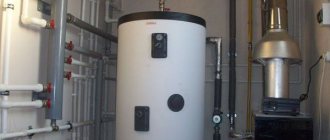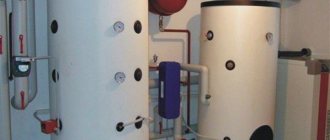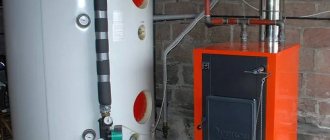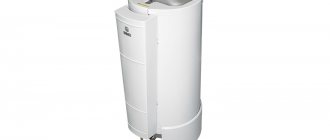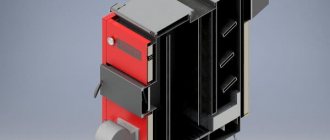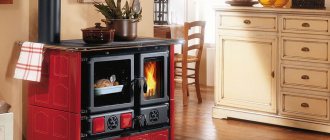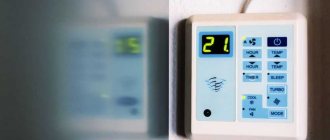What is a heat accumulator and what function does it perform?
When the combustion is strong, the system overheats; when it is weak, it cools down. The amplitude can be reduced and the period of oscillations can be increased by using a large tank with a heat accumulator. The latter is a heat exchanger with a large container filled with heat transfer fluid. One part of the system takes excess energy from the boiler, the second gradually releases heat into the heating system, preventing the temperature from dropping sharply. This entire process occurs automatically through coils controlled by three-way valves.
In other words. TA will allow you to load a full firebox of wood and not worry that the water in the boiler will boil. After the fuel burns out, the heating system will still be able to operate for some time due to the heat accumulated in the tank.
Operating principle
A heat accumulator is a container within which a hot coolant fluid circulates. The temperature is maintained in the desired range thanks to the dosing of energy transferred to the circuit. The heated tank releases heat into the rooms gradually. As a result, there is no need to constantly maintain combustion in the boiler furnace.
Video review of such a system
Advantages of thermal accumulators
The mechanism of operation of the thermal accumulator
The heat accumulator can fully replace the hot water boiler. Moreover, both devices are comparable in cost.
However, the heat accumulator will not only provide hot water supply, but will also solve a whole range of additional problems. By using a solid fuel boiler with a heat accumulator, you can get many advantages:
- the service life of heating equipment increases several times;
- the boiler will never operate at maximum loads or idle;
- the temperature of the heating supply to the house is equalized. If the water in the boiler does not have time to heat up, hot coolant is automatically supplied from the reserve tank. Conversely, excess temperature of the carrier will be selected and accumulated;
- a correctly selected container continues to take heat from the boiler even with complete combustion of the fuel;
- resource savings reach 30%.
The advantages of batteries have been appreciated by many manufacturers of solid fuel boilers.
And now they provide their equipment warranties only if additional tanks are installed. Date: September 25, 2022
Advantages and disadvantages of heating with a heat accumulator
The advantages of such systems are:
- Reduced energy costs.
- Increasing the efficiency of the heating system.
- No overheating.
- Reducing the amount (frequency) of loading solid fuel into the boiler.
- Fine-tuning the temperature in the rooms.
- Possibility of modernization (combination with a hot water supply system, use of alternative energy sources instead of fuel).
With all the advantages, heating equipment of this type also has disadvantages :
- The power of the installed boiler allows you to heat an area twice as large as required (power reserve).
- The system takes a long time to start from a cold state before entering normal operating mode.
- Due to the bulkiness of the equipment and the large number of components, transportation, placement and installation are complicated.
- There remains a need for a fuel warehouse in close proximity to the boiler room.
- The cost of equipment and the lack of quick payback, especially when replacing the boiler.
The last drawback can be successfully solved by installing the heat accumulator with your own hands.
Types of heating systems with heat storage and different numbers of coils
The coil plays the role of a heat exchanger, that is, liquids of different systems do not mix with each other, and heat transfer occurs through the walls of this spiral. Made from copper or stainless steel. Sometimes ferrous metal is used to reduce the cost of the structure.
There are four main types of systems:
Without coil . Instead, an additional tank of smaller diameter can be installed, connected to a small circuit. Heat transfer occurs due to the physical properties in which it rises up and the cold coolant falls to the bottom of the container. This system is the simplest and works with only one consumer, for example a heating system and one source. This can be either a solid fuel boiler or a solar collector. Features: minimal cost, ease of installation.
With one coil . The spiral is located inside the main tank; coolant from the source circulates through it. The energy is transferred to a storage tank from where it is circulated further to the consumer. The peculiarity of such a system is that there is no mixing of different coolants. This may be important if they have different chemical compositions.
The system can also work in the reverse order; the heating system or hot water supply can flow through the coil.
With two coils . An additional small heat exchanger circuit is fed into a system connected to an alternative energy source. This system allows the use of a wider range of equipment for heating the coolant.
Using a heat accumulator in different heating systems
DHW scheme
Heat accumulators show themselves effectively when used in a wide variety of heating systems. Moreover, in each case, such a storage device allows you to significantly save on heating.
Most often, solid fuel heating systems are equipped with heat accumulators. The installation will contribute to more economical fuel consumption and efficient heating, and will also prevent premature wear of heating radiators.
A heat accumulator would also be useful in an electric heating system, especially in regions with double tariffs for electricity. At night, when electricity is sold to consumers at a more affordable cost, the battery will accumulate heat. During the day, it will be possible to turn off the boiler for a while and heat it using the heat accumulator.
Storage tanks are also used in multi-circuit heating systems. Thanks to them, the distribution of coolant between the circuits is ensured. Installation of pipes can be done at different heights, which will allow receiving water heated to different temperatures.
Connection diagrams
Complete TA connection diagram for the heating system
The simplest connection diagram assumes the presence of a boiler heating circuit ring. This will make it possible to reduce the heating time of the main circuit. The thermostat will not allow cold coolant (water or glycol) to pass through the heat accumulator until the temperature is established at the required level.
As soon as this happens, the coolant is distributed in two directions:
- Warming up the TA.
- Warming up the main tank.
In the latter case, it is assumed to be mixed with the coolant and redirected to the tank. This increases efficiency and reduces the warm-up time of the main circuit. This connection allows the system to operate autonomously (with the pump turned off).
A separate circuit communicates with the TA and radiators. To eliminate the need to control the operation of the heating system, two bypasses are introduced into its structure:
- Contains a ball valve that closes when the pump is off. The check valve is activated.
- If the pump is stopped and the ball valve is out of order, the coolant is pumped through the second (backup) bypass.
The circuit can be simplified by eliminating the check valve. This is done on the basis that it is characterized by high flow resistance. When taking this step, you need to remember that in the event of a power outage, you will have to manually open the ball valve.
A more complex system using an alternative energy source and a hot water circuit
If outages are possible, an alternative power source or uninterruptible power supply is included in the system. This will require additional costs. The feasibility of purchasing this equipment appears after calculating the cost of pipes, fittings, pumps and valves, which may become unusable. As a result, purchasing a UPS (uninterruptible power supply) does not seem too expensive.
Detailed video review of the system
Calculation of heat storage volume
A volume that is too small is ineffective, a large volume is impractical in terms of costs and loss of usable area of the room. An accurate calculation cannot be performed due to the lack of information about the heat loss of the building, especially if it is at the design stage.
However, it is possible to calculate as approximately as possible. The initial data is the boiler power and the total area of all heated premises. Calculations are made as follows:
- The heater power in kilowatts is directly related to the area. 1KW is capable of heating 10 m2. If the house is 120 m2, then the boiler should produce 12 kW. It is necessary to provide a reserve so that the equipment does not operate at maximum load (average coefficient - 1.5). It turns out that you need to install an 18 kW boiler.
- Neglecting the volume of liquid in pipes and radiators, it is assumed that every kilowatt of power is spent on heating 25 liters. coolant in the heat accumulator. Multiplying the two values, we get 450 liters. This value is not the maximum, because at the last step a power reserve of 50% was included.
The best known manufacturers and models: characteristics and prices
Sunsystem PS 200
A standard inexpensive heat accumulator, perfect for a solid fuel boiler in a small private house with an area of up to 100-120 m2. By design, this is a regular tank, without heat exchangers. The capacity of the container is 200 l at a maximum permissible pressure of 3 bar. For a low cost, the model has a 50 mm layer of polyurethane thermal insulation and the ability to connect a heating element.
Hajdu AQ PT 500 C
One of the best buffer tank models for its price, equipped with one built-in heat exchanger. Volume – 500 l, permissible pressure – 3 bar. An excellent option for a house with an area of 150-300 m2 with a large power reserve of a solid fuel boiler. The line includes models of different sizes.
Starting with a volume of 500 l, models (optional) are equipped with a layer of polyurethane thermal insulation + an artificial leather casing. Installation of heating elements is possible. The model is known for extremely positive reviews from owners, reliability and durability. Country of origin: Hungary.
S-TANK AT PRESTIGE 300
Another inexpensive buffer tank with a capacity of 300 liters. The design is a storage tank without additional heat exchangers with a maximum permissible operating pressure of 6 bar. The internal walls, as in previous cases, are made of carbon steel. The main difference is a significant, environmentally friendly layer of thermal insulation made of polyester material using NOFIRE technology, i.e. high class thermal and fire resistance. Country of origin: Belarus
ACV (ATsV) LCA 750 1 CO TP
A productive, expensive buffer tank with a volume of 750 liters with an additional tubular heat exchanger for domestic hot water, designed for boilers with a large power reserve.
The internal walls are covered with protective enamel and there is a high-quality 100 mm layer of thermal insulation. A magnesium anode is installed inside the tank, which prevents the accumulation of a layer of solid salts (the kit includes 3 spare anodes). It is possible to install heating elements and additional instrumentation. Country of origin: Belgium.
Online calculator
*If the calculator shows 0 (zero), it means you have no excess energy to accumulate.
Explanations:
The rated power of the boiler is indicated by the manufacturer. If the documents for the equipment have not been preserved, you can find the specifications on the Internet.
The power needed to heat your home. It is calculated by specialists using a complex form, which includes: the volume of the room, the heating system, and the energy efficiency of the entire house.
Supply and return temperatures. If the system does not have thermometers installed, it can be removed with any heat remover.
How to make a heat accumulator with your own hands
This question arises when a person finds out the price of such equipment, depending on the number of coils and the material of manufacture, it ranges from 400-1500 cu. Which is not affordable for everyone.
Device diagram
TA is a cylindrical or rectangular container made of metal. The dimensions are determined by the required volume obtained as a result of the calculations given earlier. Wall thickness 2-3 mm.
The sheet is cut using a plasma cutter, grinder, guillotine or welding machine. It is also sewn together using welding. Maximum weld quality is ensured by gas welding, but inverter welding can also achieve the desired result. In any case, the quality of the welds will need to be checked under pressure of up to 4 atmospheres. The end walls of the cylinder are closed with flat metal circles of the same thickness.
Steel or stainless steel
Today on the market you can purchase such containers from both black steel and stainless steel. Manufacturers claim that it is worth taking only the last option since it is not subject to corrosion, but it also costs 2-2.5 times more. What to choose? In fact, there is no money for stainless steel, feel free to take ferrous metal. A thickness of 3 mm will last for many years, since this container is constantly filled with water and the oxygen it contains is not enough for corrosion to form.
The only problem is that when the water is drained, dampness remains inside for a certain time. But the metal thickness reserve is enough for this not to be a problem. From my experience: heat accumulators have been in operation for about 10 years, no problems with corrosion were found during the audit.
A curved smooth or corrugated pipe acts as a heat exchanger. Purchasing a magnesium anode will eliminate the danger of quickly covering the structure with corrosion.
Example drawing
It is necessary to prepare a drawing in advance and mark the inlet and outlet openings for inserting the heat exchanger and two more connections to the main circuit. Input on top, output on bottom. Fittings cut into the walls. Two additional holes with pipes must be made in the bottom and top cover. One for draining the coolant, the second for the air vent (will eliminate excess pressure inside the tank).
To ensure that the container, especially if the shape is not cylindrical, does not swell after filling, stiffening ribs are installed around the perimeter, at a distance of 320-380 mm from each other (outside the tank). They are made from a metal strip 3 mm thick. Inside, each ring is tightened by two diametrical wall reinforcements, perpendicular to each other. The same is done with the end walls (the amplifier connects the centers of the circles).
Manufacturing recommendations
From the previous section it follows that you won’t be able to get away with an ordinary 200 liter barrel, unless its capacity is at least half a cube. This is enough for a house with an area of 30 m2, and even then not for long. In order not to waste time and effort, you need to
From the point of view of placement in the boiler room, it is better to make a rectangular container. The dimensions are arbitrary, the main thing is that their product is equal to the calculated volume. The ideal option is a stainless steel tank, but ordinary metal will also work.
At the top and bottom, a self-made heat accumulator must be equipped with pipes for connection to the system. To prevent the steel walls from bulging outward under water pressure, the structure must be strengthened with ribs or jumpers.
The battery tank must be properly insulated, including from below. For this purpose, foam plastic with a density of 15-25 kg/m3 or mineral wool in slabs with a density of at least 105 kg/m3 are suitable. The optimal thickness of the thermal insulation layer is 100 mm. The resulting device, filled with coolant, will have a decent weight, so a foundation will be required for its installation.
Advice. If you need a container for a gravity heating system, you should install it yourself on a metal stand, not forgetting to insulate the lower part. The goal is to raise the tank above the level of the batteries.
